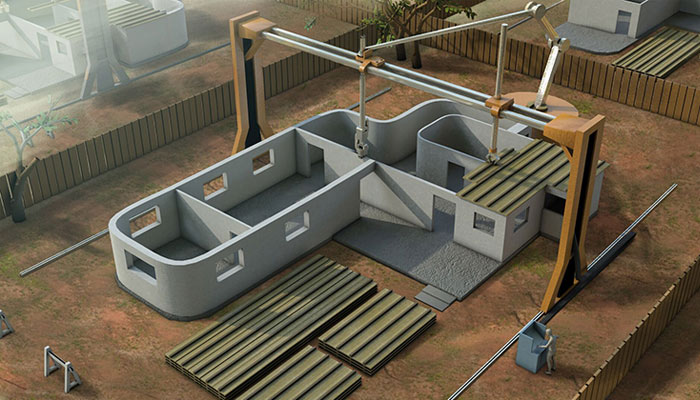The Advancement of Infrastructure with 3D Fabrication Innovations
As we navigate through the evolving sphere of innovation, one discovery stands prominently in the industry of infrastructure: 3D manufacturing. This exceptional approach is revolutionizing the method structures and frameworks are designed and constructed, ushering in a new phase of effectiveness, environmental responsibility, and innovation. Revolutionizing Construction: One Layer at a Time The adoption of 3D manufacturing in infrastructure delivers numerous game-changing gains. Chief among these is the drastic reduction in material excess. Traditional infrastructure approaches usually result in considerable waste resources that add to ecological pollution. In opposition, 3D fabrication applies a meticulous layer-by-layer approach, consuming only the necessary amount of resource and thus reducing waste greatly. Another compelling advantage is the dramatic decline in development time. Projects that traditionally take extended durations can be finalized in a segment of the duration with 3D fabrication technologies. This acceleration is due to the automated nature of 3D machines that can operate 24/7 without human intervention, greatly reducing overall project deadlines. Moreover, 3D printing unlocks possibilities for constructing complex, custom designs at no added cost. The adaptability of 3D machines permits for elaborate patterns and shapes to be created that would either be exceptionally expensive or unfeasible to achieve with standard building techniques. This function not only enhances architectural beauty but also allows engineers to maximize designs for enhanced functionality and longevity.  Reducing Expenditures and Boosting Accessibility Budget minimization is yet another notable advantage brought about by 3D fabrication in infrastructure. By cutting workforce costs and slashing the timeline necessary to finalize undertakings, the total cost tied to constructing edifices is minimized. Furthermore, affordable 3D printing machines are getting more attainable, placing this technology attainable for emerging companies and independent creators keen to experiment with its possibilities. The affordability of these devices also opens opportunities for creativity in related areas such as clothing printing. While mainly acknowledged in infrastructure circles, the scope of 3D fabrication extends into numerous domains including fashion. Here, designers experiment with 3D manufactured attire, expanding creative limits and reshaping material handling while gaining low manufacturing expenditures. A Green Era Fueled by Technology Sustainability is another cornerstone of this technology’s attraction in the building field. 3D fabrication encourages a sustainable method to construction by reducing material surplus and power expenditure. Moreover, it facilitates the integration of eco-friendly resources like repurposed plastics or blended mixtures, which further decreases the ecological effect of this conventionally high-emission field. The international shift towards green practices discovers a reliable ally in 3D printing systems, possibly revolutionizing how building guidelines and criteria are developed moving ahead. By adopting these innovative techniques, the construction sector steps closer to achieving sustainable operational models. Bringing Dreams to Life Picture public facilities in underprivileged areas being built within a short time to meet urgent demands or architects creating marvels reminiscent of organic patterns that merge perfectly into their environments – such scenarios are not just speculative but are quickly becoming achievable through 3D fabrication. While these breakthroughs mark just the onset, they suggest a era where development integrates harmoniously with both cultural aspirations and sustainable care. If we proceed on this path, infrastructure will not only mean the tangible development of spaces but also signify a dedication to forward-thinking thinking and responsible living. Connecting creativity with functionality, 3D fabrication is set to reshape our tangible environment in forms we are just beginning to understand. Through constant advancements and an embracing of these cutting-edge approaches, our constructed environments will surely morph into reflections of collective ingenuity fueled by the precision and limitless possibilities of 3D fabrication. To read more about may in 3d gia rejust go to the best web portal
Reducing Expenditures and Boosting Accessibility Budget minimization is yet another notable advantage brought about by 3D fabrication in infrastructure. By cutting workforce costs and slashing the timeline necessary to finalize undertakings, the total cost tied to constructing edifices is minimized. Furthermore, affordable 3D printing machines are getting more attainable, placing this technology attainable for emerging companies and independent creators keen to experiment with its possibilities. The affordability of these devices also opens opportunities for creativity in related areas such as clothing printing. While mainly acknowledged in infrastructure circles, the scope of 3D fabrication extends into numerous domains including fashion. Here, designers experiment with 3D manufactured attire, expanding creative limits and reshaping material handling while gaining low manufacturing expenditures. A Green Era Fueled by Technology Sustainability is another cornerstone of this technology’s attraction in the building field. 3D fabrication encourages a sustainable method to construction by reducing material surplus and power expenditure. Moreover, it facilitates the integration of eco-friendly resources like repurposed plastics or blended mixtures, which further decreases the ecological effect of this conventionally high-emission field. The international shift towards green practices discovers a reliable ally in 3D printing systems, possibly revolutionizing how building guidelines and criteria are developed moving ahead. By adopting these innovative techniques, the construction sector steps closer to achieving sustainable operational models. Bringing Dreams to Life Picture public facilities in underprivileged areas being built within a short time to meet urgent demands or architects creating marvels reminiscent of organic patterns that merge perfectly into their environments – such scenarios are not just speculative but are quickly becoming achievable through 3D fabrication. While these breakthroughs mark just the onset, they suggest a era where development integrates harmoniously with both cultural aspirations and sustainable care. If we proceed on this path, infrastructure will not only mean the tangible development of spaces but also signify a dedication to forward-thinking thinking and responsible living. Connecting creativity with functionality, 3D fabrication is set to reshape our tangible environment in forms we are just beginning to understand. Through constant advancements and an embracing of these cutting-edge approaches, our constructed environments will surely morph into reflections of collective ingenuity fueled by the precision and limitless possibilities of 3D fabrication. To read more about may in 3d gia rejust go to the best web portal